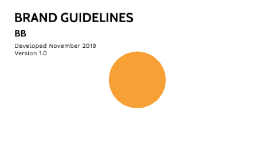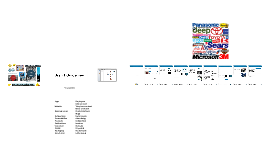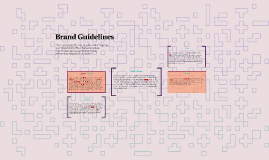Brand Guidelines
Transcript: Photos Reusable assets Brand Guidelines Ante molestie mattis arcu gravida viverra adipiscing volutpat. Ultrices eget viverra eu lectus ullamcorper. Consequat dictum tristique lectus augue felis nascetur amet non. Velit sit placerat tincidunt integer amet massa justo risus netus. Ornare sagittis malesuada varius cursus ipsum erat libero metus eget. Colors Assets Best Practices for Consistent Branding 04 01 02 03 Title Aa Aa Subtitle S M W T T S F Paragraph Aa Aa Imagery Style Why Conduct Market Research? Digital Presence What are the Future Goals? Application Rules Define the visual style of images used (e.g., photography, illustrations). Specify subjects that reflect the brand's personality and values. Include guidelines on image tone (warm, cold, vibrant, muted). Detail image resolution and quality requirements for both print and digital. Explain the appropriate use of graphics vs. photos within materials. Understanding Competitors: Identifying strengths, weaknesses, and market positions. Customer Insights: Gaining insights into customer needs, preferences, and behaviors. Trends Analysis: Examining current trends to anticipate future market developments. Data-Driven Decisions: Utilizing data to refine strategies and improve effectiveness. Risk Mitigation: Reducing uncertainties related to product launches or marketing strategies. Ensure website design aligns with brand identity (colors, fonts). Maintain consistency in tone across all digital channels. Optimize for user experience: fast loading times, mobile-friendly. Use branded visuals and imagery throughout the site. Regularly update content to reflect current brand messages. Brand Growth: Establishing measurable objectives for revenue, market presence, and reach. Product Development: Plans for introducing new products or services. Customer Engagement: Strategies to enhance customer interaction and satisfaction. Sustainability Initiatives: Incorporating eco-friendly practices and corporate responsibility in goals. Long-Term Vision: Defining where the brand aims to be in the next 5-10 years. Adhere to the defined logo sizes and clear space requirements to maintain visibility and impact. Use the established color palette consistently across all platforms to reinforce brand identity. Implement typography as specified, using designated fonts and styles for various applications. Ensure that all branding materials reflect a standardized look and feel to avoid confusion. Keep updates to branding elements uniform and timely to maintain the overall strategy. Logo Usage Typography Tone of Voice Letterhead Social Media Guidelines Maintain clear space around the logo to ensure visibility. Use the logo in its original form; do not alter colors or proportions. Apply the logo consistently across all platforms (digital and print). Ensure the logo contrasts well with background colors for better legibility. Follow specific guidelines for logo placement in different media. Identify the brand’s personality (formal, casual, friendly, authoritative). Establish guidelines for language usage (e.g., vocabulary, phrasing). Detail how tone should vary across different communication channels. Provide examples of do’s and don’ts in messaging. Highlight the importance of consistency in tone across all customer touchpoints. Incorporate logo and brand colors in header. Use appropriate typography that reflects brand voice. Maintain consistent spacing and margins for a clean layout. Include company address and contact details formatted uniformly. Consider watermarking elements for added professionalism. Establish font families for titles, headings, and body text. Include guidelines on font sizes for consistency in readability. Specify styles (bold, italic, etc.) and their appropriate contexts. Recommend line spacing and letter spacing for optimal legibility. Provide examples of incorrect uses of typography to avoid. Use consistent logos and profile images across platforms. Establish a tone of voice that reflects brand values. Create a posting schedule that aligns with brand goals. Utilize branded hashtags to enhance visibility. Brand Strategy Visual Elements Business Cards Color Palette What is the Messaging Framework? Merchandise An effective brand strategy defines a clear path for a brand's identity, positioning, and engagement within the market. Key components include understanding the target audience, establishing strong brand positioning, creating a messaging framework, conducting thorough market research, and setting future goals. Maintain a consistent approach to the imagery used across all marketing platforms. Select images that reflect the brand's essence and values, aligning with target audience perceptions. Use graphic elements such as lines, shapes, and icons consistently to create a cohesive visual identity. Ensure all videos and multimedia content adhere to visual style guidelines to enhance recognition. Create a library of approved images and graphics to streamline the

















